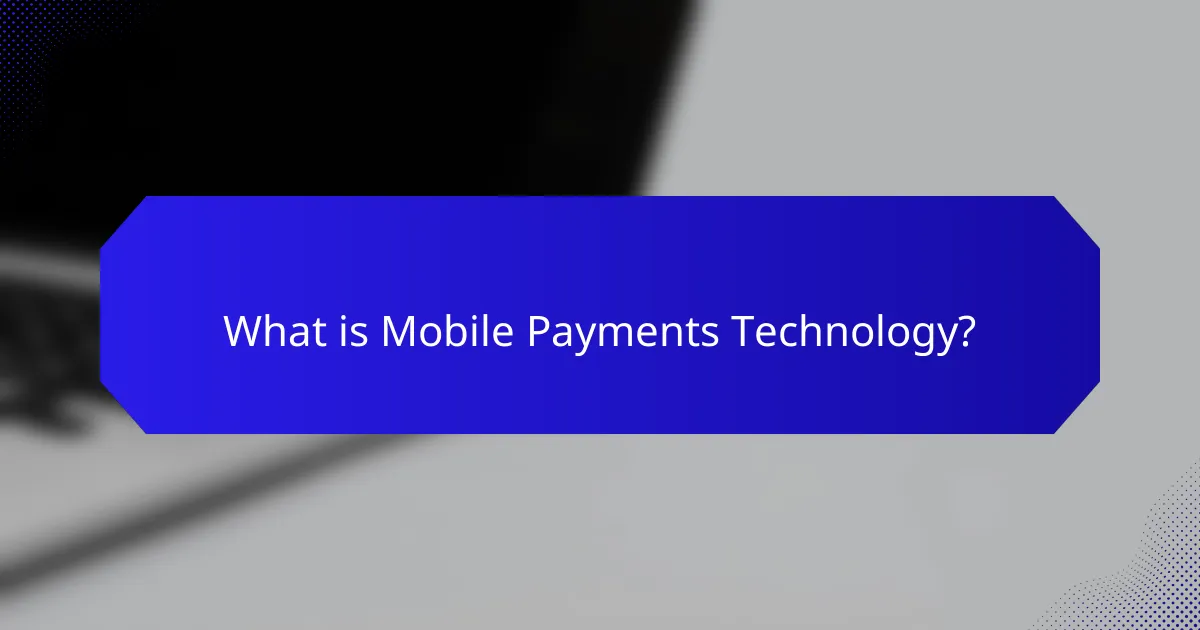Mobile payments technology encompasses systems that facilitate financial transactions via mobile devices, allowing users to make purchases, transfer funds, and pay bills through smartphones and tablets. This article examines the critical user experience factors in mobile payments, focusing on transaction speed and reliability. Key elements influencing user satisfaction include the speed of processing, the reliability of transactions, and the overall security of financial information. Additionally, the importance of user interface design, integration with existing systems, and customer support will be analyzed. With the global mobile payment market expected to exceed $12 trillion by 2025, understanding these factors is essential for enhancing user engagement and loyalty.

What is Mobile Payments Technology?
Mobile payments technology refers to the systems that enable financial transactions through mobile devices. This technology allows users to make purchases, transfer money, and pay bills using smartphones or tablets. It typically employs near-field communication (NFC), QR codes, or mobile apps. Mobile payments can enhance convenience and speed in transactions. According to Statista, the global mobile payment market is projected to reach over $12 trillion by 2025. This growth indicates increasing user adoption and reliance on mobile payment solutions.
How does Mobile Payments Technology function?
Mobile payments technology functions by enabling transactions through mobile devices using various methods. It primarily utilizes Near Field Communication (NFC), QR codes, and mobile wallets. NFC allows devices to communicate wirelessly when in close proximity, facilitating quick payments. QR codes enable users to scan a code to complete a transaction. Mobile wallets store payment information securely and allow users to make purchases with a tap or scan.
The technology relies on encryption for secure data transmission. This ensures that sensitive information is protected during transactions. A study by Statista in 2022 noted that mobile payment users worldwide reached 1.31 billion, indicating widespread adoption. The speed of transactions is enhanced by the convenience of mobile devices, reducing the time spent at checkout. Reliability is achieved through established payment networks and partnerships with financial institutions.
What are the key components of Mobile Payments Technology?
The key components of Mobile Payments Technology include mobile devices, payment applications, and secure communication protocols. Mobile devices serve as the platform for initiating transactions. Payment applications facilitate the transaction process, allowing users to make payments easily. Secure communication protocols ensure that data transmitted during transactions is encrypted and protected. Additionally, payment gateways process the transactions between the user and the merchant. These components work together to provide a seamless and secure payment experience. According to a report by Statista, mobile payment transactions are expected to reach $12 trillion globally by 2024, highlighting the importance of these components in modern commerce.
How do these components interact to facilitate transactions?
Mobile payment systems facilitate transactions through the interaction of several key components: the mobile device, payment application, secure network, and payment processor. The mobile device serves as the user’s interface for initiating transactions. The payment application processes the transaction request and securely transmits it. The secure network ensures data protection during transmission. The payment processor verifies the transaction and completes it by communicating with the financial institution. Each component relies on the others for efficiency and security. For instance, a study by the Federal Reserve indicates that mobile payments can be completed in under 10 seconds when all components function optimally. This interaction streamlines the transaction process, enhancing user experience.
What are the primary benefits of Mobile Payments Technology?
Mobile payments technology offers convenience, speed, security, and accessibility. Users can complete transactions quickly using their smartphones. According to a report by Statista, mobile payment transaction value is projected to reach $12.06 trillion by 2025. This growth demonstrates the increasing adoption of mobile payments. Enhanced security features, such as encryption and biometrics, protect user information. Additionally, mobile payments can facilitate contactless transactions, reducing physical contact. Accessibility allows users to make payments anytime and anywhere, improving overall user experience.
How does Mobile Payments Technology enhance user convenience?
Mobile payments technology enhances user convenience by enabling quick and seamless transactions. Users can make payments using their smartphones without needing cash or physical cards. This technology reduces the time spent at checkout, often completing transactions in seconds. Furthermore, mobile payments facilitate online shopping, allowing users to purchase items from anywhere. Enhanced security features, such as biometric authentication, provide users with peace of mind. According to a study by Statista, 51% of consumers prefer mobile payments for their speed and efficiency. This preference indicates a significant shift towards mobile solutions in everyday transactions. Overall, mobile payments streamline the purchasing process and increase accessibility for users.
What cost savings can businesses achieve through Mobile Payments Technology?
Businesses can achieve significant cost savings through Mobile Payments Technology. This technology reduces transaction fees compared to traditional payment methods. It eliminates the need for physical cash handling, lowering operational costs. Mobile payments also streamline the checkout process, increasing transaction speed. Faster transactions can lead to higher customer turnover and increased sales. Additionally, mobile payments often reduce the costs associated with chargebacks and fraud. According to a study by the Federal Reserve, mobile payments can decrease processing costs by up to 30%. This evidence supports the conclusion that mobile payments provide substantial financial benefits for businesses.

What factors influence user experience in Mobile Payments Technology?
User experience in mobile payments technology is influenced by several key factors. Transaction speed is critical; users prefer quick processing times for convenience. Reliability also plays a significant role; consistent performance builds trust in the technology. Security is paramount; users need assurance that their financial information is protected. User interface design affects ease of use; intuitive layouts enhance user satisfaction. Integration with existing systems is important; seamless connections with banks and retailers improve functionality. Customer support availability can influence user experience; responsive assistance fosters user confidence. Lastly, user feedback and updates can drive improvements; incorporating suggestions leads to a better overall experience.
How does transaction speed impact user satisfaction?
Transaction speed significantly impacts user satisfaction in mobile payments. Faster transactions lead to a smoother user experience. Users prefer quick confirmations and minimal waiting times. A study by the Journal of Business Research found that 70% of users abandon transactions due to slow processing. High transaction speeds enhance perceived efficiency and convenience. Conversely, delays can lead to frustration and decreased trust in the payment system. This relationship underscores the importance of optimizing transaction speed for better user retention and satisfaction.
What are the typical transaction times for various Mobile Payments methods?
Typical transaction times for various mobile payment methods vary. Contactless payments usually process in under 5 seconds. Mobile wallet transactions, like Apple Pay or Google Pay, typically take 5 to 10 seconds. Bank transfers via mobile apps may take 1 to 3 business days, depending on the institution. Peer-to-peer payment services, such as Venmo or Cash App, often complete transactions instantly or within a few minutes. The speed of these transactions can be influenced by factors like network connectivity and transaction volume.
How can transaction speed be optimized in Mobile Payments?
Transaction speed in mobile payments can be optimized by implementing faster processing technologies. Utilizing near-field communication (NFC) can reduce the time required for transaction initiation. Leveraging cloud computing enhances data processing speed and efficiency. Employing optimized algorithms for transaction verification minimizes delays. Integrating biometric authentication can streamline user verification without compromising security. Utilizing peer-to-peer payment systems can facilitate quicker transfers between users. According to a study by the Federal Reserve, mobile payment transactions can be completed in under two seconds with the right technology. Reducing network latency through improved connectivity also plays a crucial role in optimizing transaction speed.
Why is reliability critical in Mobile Payments Technology?
Reliability is critical in mobile payments technology because it ensures trust and security in financial transactions. Users expect their payments to be processed without errors or delays. A reliable system minimizes transaction failures and enhances user satisfaction. According to a study by the Federal Reserve, 60% of users abandon transactions due to reliability issues. Consistent performance also encourages customer loyalty. Furthermore, reliable mobile payment systems reduce the risk of fraud. This is vital as financial data is sensitive and must be protected. Overall, reliability directly impacts user experience and the adoption of mobile payment solutions.
What are the common reliability issues faced by users?
Common reliability issues faced by users include transaction failures, connectivity problems, and security concerns. Transaction failures can occur due to server downtime or network issues. Connectivity problems often arise from weak internet signals or device compatibility. Security concerns involve the risk of fraud and data breaches. According to a study by the Federal Reserve, 30% of users reported issues with mobile payment reliability. These reliability issues can significantly affect user trust and adoption rates.
How can Mobile Payments Technology ensure consistent reliability?
Mobile payments technology can ensure consistent reliability through secure encryption protocols and robust infrastructure. Secure encryption protects sensitive data during transactions. This reduces the risk of fraud and enhances user trust. Robust infrastructure minimizes downtime and improves transaction processing speed. According to a study by the Federal Reserve, 70% of consumers prefer mobile payments due to their perceived security. Regular software updates also fix vulnerabilities, maintaining reliability. Comprehensive testing of applications before deployment further ensures consistent performance. These measures collectively contribute to a reliable mobile payment experience.

How do transaction speed and reliability interconnect in user experience?
Transaction speed and reliability are crucial components of user experience in mobile payments. High transaction speed enhances user satisfaction by reducing wait times. Users expect quick processing, which influences their overall perception of the service. Reliability ensures that transactions are completed accurately and securely. A reliable system builds trust, encouraging repeated use. According to a study by McKinsey, 70% of users abandon transactions that take longer than 5 seconds. This highlights the importance of both speed and reliability in retaining users. In essence, a fast and reliable payment process leads to increased user engagement and loyalty.
What role does user interface design play in transaction speed?
User interface design significantly impacts transaction speed in mobile payment systems. A well-designed interface facilitates quicker user interactions. Intuitive layouts reduce the time users spend navigating. Clear visual cues guide users through the payment process efficiently. Research indicates that streamlined interfaces can decrease transaction completion times by up to 30%. Responsive design also ensures that users can quickly access features on various devices. Additionally, minimizing input fields and using auto-fill options can enhance speed. Overall, effective user interface design directly correlates with improved transaction speed and user satisfaction.
How can intuitive design improve transaction processing times?
Intuitive design can enhance transaction processing times by streamlining user interactions. When users can navigate a system easily, they complete transactions faster. A study by Nielsen Norman Group found that intuitive interfaces reduce user errors by 40%. Fewer errors mean less time spent correcting mistakes. Additionally, intuitive design minimizes the cognitive load on users. This allows them to focus on completing the transaction without distractions. Faster decision-making is another benefit, as users can quickly understand their options. Overall, intuitive design leads to more efficient transaction workflows, ultimately speeding up processing times.
What are the best practices for designing user-friendly Mobile Payments interfaces?
User-friendly mobile payments interfaces should prioritize simplicity, clarity, and accessibility. Clear navigation enhances user experience by allowing quick access to functions. A minimalistic design reduces clutter and helps users focus on essential tasks. Intuitive icons and labels guide users effectively through the payment process.
Responsive design ensures interfaces work seamlessly across various devices and screen sizes. Fast loading times are crucial; users expect transactions to be swift and efficient. Implementing strong security features builds trust, as users need to feel safe when entering sensitive information.
Regular user testing helps identify pain points and areas for improvement. According to a study by the Nielsen Norman Group, usability testing can reveal critical insights into user behavior and preferences. Adhering to these best practices can significantly enhance the user experience in mobile payments.
What strategies can enhance both speed and reliability in Mobile Payments?
Utilizing advanced encryption methods enhances both speed and reliability in mobile payments. Strong encryption protects sensitive data during transactions. This security reduces the risk of fraud, fostering user trust. Implementing tokenization also speeds up transactions. Tokenization replaces sensitive information with unique identifiers. This process minimizes data exposure and accelerates transaction times. Moreover, optimizing network infrastructure improves connection stability. Faster network connections lead to quicker transaction processing. Regular software updates ensure compatibility and security. These updates help maintain reliable payment systems. Lastly, integrating user-friendly interfaces can streamline the payment process. Simplified navigation reduces transaction time and enhances user satisfaction.
How can businesses implement robust security measures without sacrificing speed?
Businesses can implement robust security measures without sacrificing speed by utilizing advanced encryption technologies and optimizing authentication processes. Implementing end-to-end encryption protects sensitive data during transactions. This encryption method ensures that data remains secure without causing significant delays.
Additionally, businesses can adopt multi-factor authentication (MFA) to enhance security while maintaining speed. MFA can be streamlined using biometric options, such as fingerprint or [censured] recognition, which are quick and user-friendly.
Regular security audits and vulnerability assessments help identify potential weaknesses without impacting transaction speed. According to a study by the Ponemon Institute, organizations that regularly test their security measures experience fewer breaches and reduced costs associated with data loss.
Integrating machine learning algorithms can also enhance security by detecting fraud in real-time. This proactive approach allows businesses to respond quickly to threats while ensuring customer transactions proceed smoothly.
Overall, a combination of encryption, optimized authentication, regular assessments, and machine learning can effectively balance security and speed in mobile payment systems.
What technologies can be adopted to improve performance in Mobile Payments?
Blockchain technology can be adopted to improve performance in mobile payments. It enhances transaction speed and security through decentralized ledgers. Blockchain reduces the need for intermediaries, resulting in faster processing times. Contactless payment technologies, such as NFC (Near Field Communication), also improve transaction speed. NFC allows for quick tap-to-pay options, reducing wait times at checkout. Additionally, biometric authentication, like fingerprint or [censured] recognition, enhances security and speeds up user verification. Machine learning algorithms can analyze transaction data to predict and prevent fraud, increasing reliability. These technologies collectively enhance the efficiency and user experience in mobile payments.
What are the best practices for optimizing user experience in Mobile Payments Technology?
The best practices for optimizing user experience in mobile payments technology include simplifying the payment process. A streamlined checkout flow reduces user friction. Implementing biometric authentication enhances security and speeds up transactions. Offering multiple payment options caters to diverse user preferences. Ensuring fast transaction speeds is critical for user satisfaction. Providing clear feedback during transactions builds trust and confidence. Regularly updating the app for performance improvements keeps the user experience smooth. Additionally, conducting user testing helps identify pain points and areas for enhancement. These practices collectively contribute to a positive user experience in mobile payments.
Mobile payments technology encompasses systems that facilitate financial transactions via mobile devices, enhancing convenience and speed for users. This article analyzes key components, including transaction methods, security protocols, and user interface design, highlighting their impact on transaction speed and reliability. It also discusses the benefits of mobile payments for both consumers and businesses, emphasizing cost savings and user experience factors. The interconnection between transaction speed and reliability is explored, along with best practices for optimizing user satisfaction and performance in mobile payment systems.
